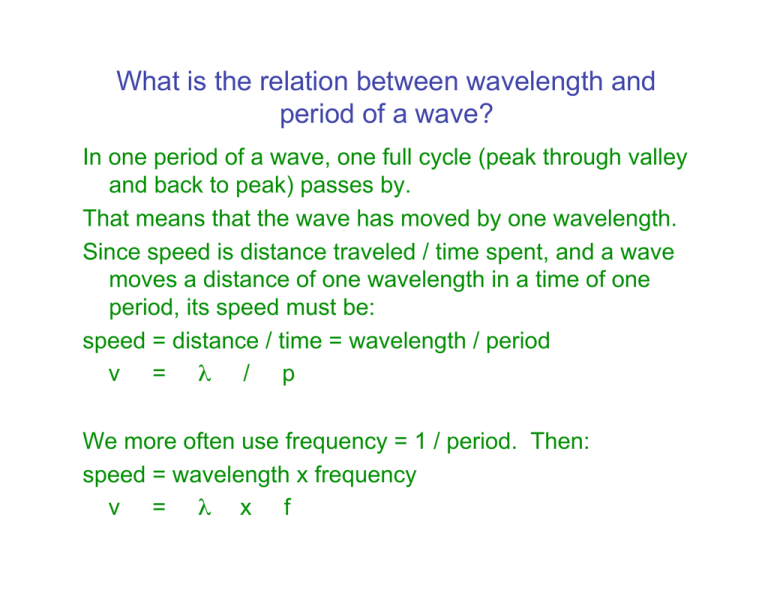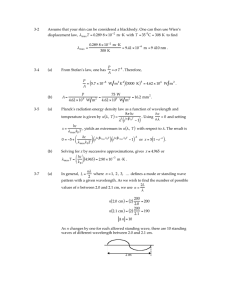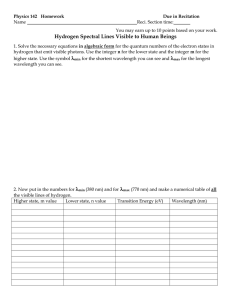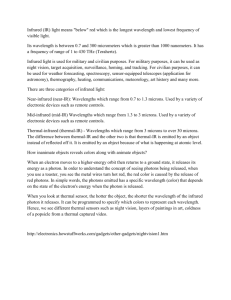What is the relation between wavelength and period of a wave?
advertisement

What is the relation between wavelength and period of a wave? In one period of a wave, one full cycle (peak through valley and back to peak) passes by. That means that the wave has moved by one wavelength. Since speed is distance traveled / time spent, and a wave moves a distance of one wavelength in a time of one period, its speed must be: speed = distance / time = wavelength / period v = λ / p We more often use frequency = 1 / period. Then: speed = wavelength x frequency v = λ x f What is light? We need two ways of looking at light: It is an electromagnetic wave. We often think of radio waves this way. In fact they are just very long wavelength light. It is also a shower of particles called photons. x-rays are usually thought of as photons. They are very short wavelength light. For visible light we need both pictures. What is a photon? Photons are small bunches of light waves. Each photon carries a certain amount of energy. What is energy? Energy is best defined by examples: a hot object has more energy than a cold one. a fast-moving object has more energy than a slow one. a rock at the top of a hill has more energy than one at the bottom (because when it rolls down it will become a fast-moving object). What is the energy of a photon? The concept of energy is useful because we have formulas for each different type of energy. The energy of a moving object = ½ mass x speed2. The amount of heat energy in an object is proportional to its absolute temperature (Centigrade + 273). If a moving object slides to a stop, its energy of motion is converted to heat energy. Einstein realized that the energy in a photon of light is proportional to the frequency of the wave in the photon, or inversely proportional to its wavelength: E=hf=hc/λ (h is a very small number, called Planck’s constant.) Spectra of gasses and solids When solids are heated they emit all wavelengths of light (a continuous spectrum). How bright the light at different wavelengths is depends on the temperature of the solid. Hotter solids emit more light of all wavelengths, but they especially emit more short wavelength (blue and violet) light. When gasses are heated they emit only certain wavelengths of light (an emission line spectrum). Different gasses emit different wavelengths. A cool object (gas or solid) can absorb some of the light passing through it. Hot solids – continuous spectra The temperature of an object is a measure of how much energy its atoms have. Since atoms in hotter objects have more energy, they can emit photons with more energy than cooler objects can. (When an atom emits a photon the photon energy comes from the atom, so an atom can’t emit a photon with more energy than the atom had.) So hot objects emit high energy photons, or short wavelength light. Since λ α 1/Ephoton and Ephoton ~ Eatom α T, λ α 1/T They also emit more photons that cooler objects do. The rule is the amount of power emitted (energy emitted each second) is Pemitted α T4 Quiz When you look at a light bulb through a piece of red plastic, the light looks red. This is because: A. The plastic absorbs the white light from the bulb and emits red light. B. The plastic shifts all of the photon wavelengths toward the red end of the spectrum. C. The plastic absorbs the green photons and converts them into red photons. D. The plastic absorbs the green photons, leaving the red. Emission line spectra Hot gas emits light of only certain wavelengths. If a source emitting a continuous spectrum lies behind cool gas, the gas absorbs some of the light, and it absorbs the same wavelengths of light that it would emit if hot. To understand why gasses act this way, we need to understand more about how electrons orbit in atoms.






